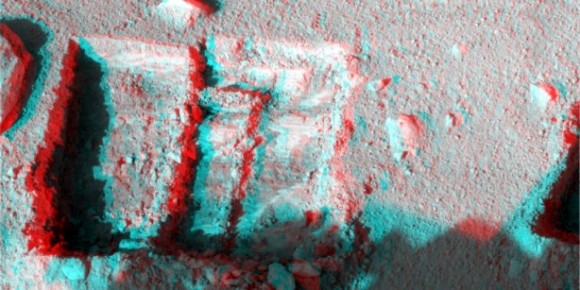[/caption]
The days are getting shorter for the Phoenix Mars Lander, and as fall approaches on Mars’ northern plains, the scientists and engineers for the mission are quickly trying get as much done before power levels on the lander drop too low for any more scientific activities. In the image here, blue-ish white frost appears on Mars surface every day now as the temperatures continue to drop. This image was taken on the 131st Martian day or sol of the mission, October 7 here on Earth. Clearly visible are the interlocking polygon shapes that form in permafrost from seasonal freezes and thaws. These polygon patterns were seen in orbital pictures taken by the Mars Reconnaissance Orbiter, as well as other spacecraft, and are part of the evidence that Mars’ north polar region harbors large quantities of frozen water.
The Phoenix Lander has dug more trenches in Mars soil in both the low troughs and high peaks of the polygons, and is scooping the soil into onboard science laboratories for analysis. About two weeks ago, Phoenix moved a rock nicknamed “Headless,” about 0.4 meters (16 inches) with its robotic arm. Then soil from under the rock was scraped up by the scoop at the end of the arm and and delivered to the lander’s optical and atomic-force microscopes.
Scientists are conducting preliminary analysis of this soil, nicknamed “Galloping Hessian.” The soil piqued their interest because it may contain a high concentration of salts, said Diana Blaney, a scientist on the Phoenix mission with NASA’s Jet Propulsion Laboratory, Pasadena, Calif.
As water evaporates in arctic and arid environments on Earth, it leaves behind salt, which can be found under or around rocks, Blaney said. “That’s why we wanted to look under ‘Headless,’ to see if there’s a higher concentration of salts there.”

Phoenix scientists also want to analyze a hard, icy layer beneath the Martian soil surface. The robotic arm has dug into a trench called “La Mancha,” in part to see how deep the Martian ice table is. The Phoenix team also plans to dig a trench laterally across some of the existing trenches in hopes of revealing a cross section, or profile, of the soil’s icy layer.
“We’d like to see how the ice table varies around the workspace with the different topography and varying surface characteristics such as different rocks and soils,” said Phoenix co-investigator Mike Mellon of the University of Colorado, Boulder. “We hope to learn more about how the ice depth is controlled by physical processes, and by looking at how the ice depth varies, we can pin down how it got there.”

Over the weekend, on the 128th Martian day, or sol, Phoenix engineers successfully directed the robotic arm to dig in a trench called “Snow White” in the eastern portion of the lander’s digging area. The robotic arm then delivered the material to an oven screen on Phoenix’s Thermal and Evolved-Gas Analyzer.
The Phoenix team will try to shake the oven screen so the soil can break into smaller lumps and fall through for analysis.
The Phoenix lander, originally planned for a three-month mission on Mars, is now in its fifth month. As fall approaches, the lander’s weather instruments detect diffuse clouds above northern Mars, and temperatures are getting colder as the daylight hours wane.
Consequently, Phoenix faces an increasing drop in solar energy as the sun falls below the Martian horizon. Mission engineers and scientists expect this power decline to curtail activities in the coming weeks. As darkness deepens, Phoenix will primarily become a weather station and will likely cease all activity by the end of the year.
Source: Phoenix news site


Good night, Phoenix. I hope you wake up again in the spring, but I hear that’s unlikely.
I was thinking the same thing Nexus. Why wouldn’t shutting it down for the Martian winter work?
Ah well, is what it is. Really sad to think that it’s “dying.”
I think that it’ll definitely be able to power up come spring on Mars, so long as it is able to survive the icing, and I don’t really think we should consider it to be dying, just going into hibernation for the winter…
Forgot to mention, they had, what, a three month life-expectancy for the Mars Exploration Rovers? Now they’re in their fifth year of work. Who knows how long Phoenix will be functioning? Long live Phoenix!!!
for many sols now we are told that phonix digs hard and fast and delivers samples to its oven for testing good on you phoenix but mans results from the testings are not forth coming whay not?
@giovanni
Digging takes a lot more power than doing chemistry experiments – so, Phoenix digs like a maniac while there is enough power to use the arm. Then when it gets too dark and cold to produce enough electricity for digging, it’ll analyse the samples… and tell us about the results.
I wonder if we’ll see images of the ice field approaching from the horizon? Or maybe Phoenix dies from the toes up as frost forms on the ground around it and gets thicker?
It’s been a great mission though! Hopefully we’ll see more surpizes before it’s death.
“I was thinking the same thing Nexus. Why wouldn’t shutting it down for the Martian winter work?”
Would the engine in your car still turn over if you never ran it all winter, and kept it out in deep cold, unattended?
Still, I have absolutely no objection to trying to get an occasional response from it, throuought the Martian winter. It would not be the first time that one of our probes suprised us by far exceeeding its design expectations…
phoenix has already exceeded her design expectations, why should the surprises stop?
As I understand it, poor Phoenix is so much further North that she’ll be entirely encased in ice come Winter. And the temperatures will drop low enough to make her components brittle. So as the ice expands and contracts she’ll most likely be broken into bits and pieces.
I want her survive too, but she’s as exposed as a surfer in the Antarctic.
Spirit and Opportunity both certainly lived upto their namesakes. Hopefully Phoenix will too…but not literally because if Phoenix bursts into flame then returns to earth on its own come spring we’ve got problems
Sili,
You are close. The cold temperatures are what is going to ‘kill’ Phoenix, but it’s not a structural problem; it won’t be in pieces come spring. The problem is the batteries will not survive being that cold.
what is really expected to kill phoenix is called “glassification”
You ever seen the demonstration where a rubber racquet ball is dropped in liquid nitrogen and then dropped? [it shatters] The ball becomes very brittle. This is what’s expected to happen to Phoenix’s circuit boards.
If it DOES wake up and send a signal, Phoenix may be heavily damaged. Probably beyond usefulness.